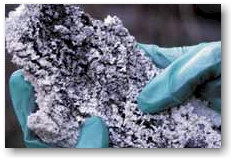Mold and Indoor Environments
 Molds are a type of fungus that can grow on indoor surfaces, and may look cottony, wooly, smooth, or velvety. The velvety looking surface is actually thousands of microscopic spores. These spores can travel through the air, land somewhere else, and grow new colonies if food, water, and warmth are present.
Molds are a type of fungus that can grow on indoor surfaces, and may look cottony, wooly, smooth, or velvety. The velvety looking surface is actually thousands of microscopic spores. These spores can travel through the air, land somewhere else, and grow new colonies if food, water, and warmth are present.
Molds are everywhere. Most indoor molds come from the outdoors, and are carried inside on our shoes, clothes, pets, through open windows, doors, and mechanical ventilation systems. Every home, office, and school in the country has some mold inside that was carried in from the outdoor environment. When there is a moisture problem in a building such as one caused by a flood, water leak, or very high humidity, the small amount of mold naturally found there may start growing.
In some cases, certain sensitive individuals may begin developing symptoms when exposed to large amounts of mold. These symptoms may include allergic reactions, asthma episodes, and other respiratory problems. It is important to remember that not all individuals are susceptible to mold.
Most mold problems in buildings are not emergencies. They can be dealt with using fairly easy techniques. Some resources to help deal with clean-up are listed below.
Here are some main points to keep in mind when evaluating a mold problem:
- Without water, mold cannot survive.
- All mold growths are potential health hazards and should be removed.
- Sampling/testing for mold is expensive and usually not necessary. If you see it, remove it.
The best way to address the mold problem is to:
- Find and fix the moisture problem.
- Clean up the mold using safe procedures.
Further information about mold may be found by clicking the links below.
General Mold Information:
Mold Testing:
Residential Structures:
- I Think I Have Mold, Should I Be Concerned?
- Mold, Moisture and Your Home (EPA)
- Damp Indoor Spaces and Health (2004 Institute of Medicine Report)
- Mold Guidance for the Real Estate, Banking, and Insurance Communities
- Toolkit for Managing Mold and Moisture in Rental Properties (Maine Indoor Air Quality Council)
- Landlord Checklist for Preventing Mold in Apartments
- Tenant Checklist for Preventing Mold in Apartments
Health Professionals:
Remediation/Abatement:
- Helpful Tips for Mold Assessment and Cleanup
- CT Guidelines for Mold Abatement Contractors
- Mold Remediation in Schools and Commercial Buildings Guide (EPA)
- A Field Guide for Flooded Home Clean-Up (NCHH)
- Flood Cleanup to Protect Indoor Air and Your Health (EPA)
- Information About Post-Flood Clean-Up
For more information contact your local health department or the Connecticut Department of Public Health, Environmental and Occupational Health Assessment Program (860) 509-7740

